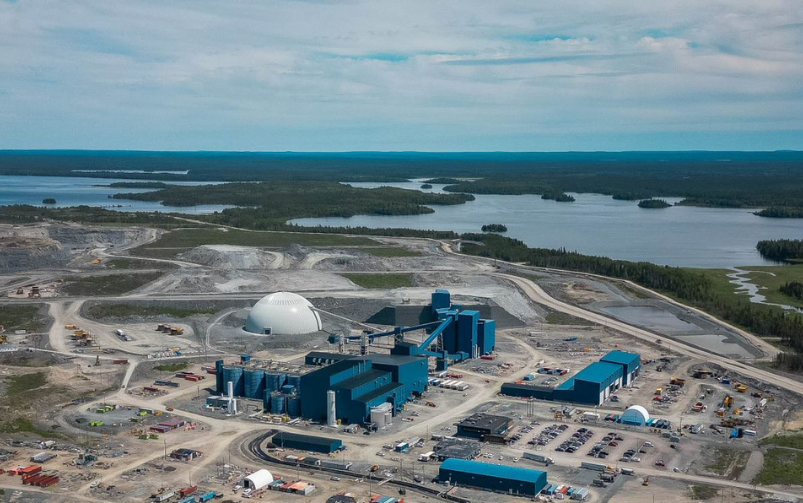An investigation has been opened following Monday’s bomb scare at Northvolt’s electric vehicle (EV) battery plant project, which is depicted in the rendering above, and is set to open by the end of 2026. Courtesy of Northvolt.
Welcome back to your weekly mining news recap, where we catch you up on some of the news you may have missed. This week’s headlines include an additional $15 million investment into Ontario’s Critical Minerals Innovation Fund, Panama’s president-elect’s conditional approach to discussions with First Quantum Minerals and three Canadian carbon removal technology firms are among the finalists competing for a US$50 million prize.
The United Nations Economic Commission for Europe (UNECE) announced on April 23 that key international standards from the Committee for Mineral Reserves International Reporting Standards (CRIRSCO) and the United Nations Framework Classification for Resources (UNFC) used in mineral reporting would be harmonized in order to make reporting and classifying minerals more straightforward. A more accessible and well-rounded guide to reporting and classifying mineral resources and reserves has been released that will be useful to Canadian miners with assets that are under the purview of international governments or European entities that must adhere to the UN’s rules or codes if they fall under the auspices of the EU or UN regulatory framework.
Swedish electric vehicle (EV) battery producer Northvolt discovered possible fire bombs on May 6 that were located beneath large machinery at the site of its $7 billion EV battery plant that is under construction approximately 30 kilometres east of Montreal, as reported by Mining.com. Back in January, the company also found nails and metal bars inserted into trees at the site that were planned to be cut down. There has been vocal opposition to the plant, which was not subject to comprehensive public consultation.
Gold production at B2Gold’s Goose open-pit and underground project in Nunavut has been delayed by three months due to equipment availability, unfavourable weather conditions and a focus on other construction tasks, as reported by Engineering News. The revised schedule means that B2Gold is now expected to pour first gold at its Goose project during the second quarter of 2025—one quarter later than previously estimated—with full production expected to commence in the third quarter.
George Pirie, Ontario’s Minister of Mines, announced on May 6 that the province will be allocating an additional $15 million over the next three years to expand the Ontario Critical Minerals Innovation Fund, as reported by Northern Ontario Business. The investment will assist in establishing the province’s supply chain to fulfill the projected demand for the critical minerals needed to develop batteries and EVs.
José Raúl Mulino, Panama’s incoming president, has made it clear that discussions with First Quantum Minerals about reopening its Cobre Panama mine are off the table until the company drops its arbitration claims against the country, as reported by Reuters. The company is seeking billions in compensation after the Panamanian government ordered First Quantum’s giant copper mine to be shut down in late 2023.
Three Canadian cleantech companies are in the running for the Xprize, a carbon removal competition funded by the Musk Foundation, as reported by The Northern Miner. Arca, one of the 20 finalists, signed a deal with BHP in November to develop a carbon dioxide mineralization project that utilizes tailings from the Mount Keith nickel mine in Western Australia. The other two Canadian finalists are Planetary Technologies and Skyrenu Technologies. The winner will be revealed in April 2025 and will receive US$50 million.
According to analysis from the Toronto-based law firm Osler, proposals made by the Canadian federal government to alter the country’s environmental regulations likely will not do much to expedite the approval process for resource projects, as reported by The Northern Miner. Osler released an analysis earlier this month stating that if the changes are made in their current state, the act could once again be deemed as unconstitutional and challenged by provinces, and the proposed changes would likely undergo modifications via a public consultation process.
Michael Lodge, the secretary-general of the International Seabed Authority (ISA)—who is an advocate for deep-sea mining and has sparred with environmentalists—is running for a third term at a pivotal time, as reported by Bloomberg. An upcoming election at a meeting in July will determine if Lodge will be replaced by Brazilian marine scientist Leticia Carvalho, who would likely have a different view on mining the seabed. The result holds weighty economic and environmental implications for deep-sea mining, with the ISA under pressure to finalize regulations that could see mining commence within the next two years.
A study conducted by researchers from Illinois’ Northwestern University has revealed that a catalyst composed of molybdenum and granulated sugar is able to eliminate carbon dioxide gas, as reported by Mining.com. After researchers used sugar as a carbon source to transform molybdenum into molybdenum carbide, the resulting catalyst was able to convert CO2 into carbon monoxide with high selectivity. The researchers say that this development could have applications in carbon capture and sequestration technology.
Those conducting feasibility studies have a tendency to misrepresent figures, resulting in unrealistic estimates, wrote Dan Kappes in the March/April issue of CIM Magazine. He argued that introducing a new section to the NI 43-101 study that seeks to compare capital and operational expenses of a project with accurate industry data could offer more transparency when it comes to producing feasibility studies.
Backfilling in underground mines in the Arctic is rife with challenges due to extreme weather and the remoteness of the region, as reported by Sarah St-Pierre in the March/April issue of CIM Magazine. One solution to combat these challenges could be frozen backfill, which is cost effective and replaces the need for cement as a binder.
That’s all for this week. If you’ve got feedback, you can always reach us at editor@cim.org. If you’ve got something to add, why not join the conversation on our Facebook, Twitter, LinkedIn or Instagram pages?




